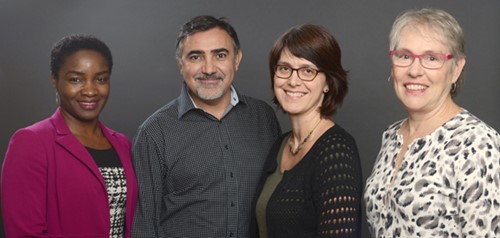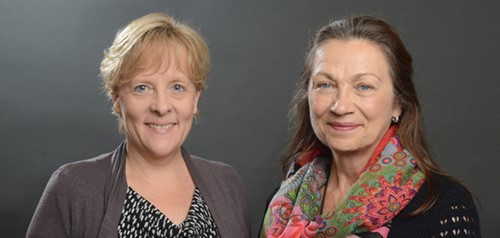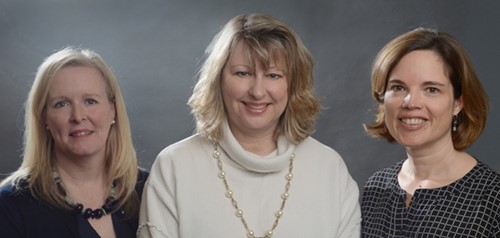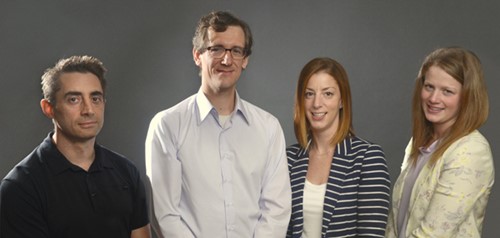2014 EXTRA Improvement Projects
Agence de la santé et des services sociaux de la Montérégie (QC)
- Julie Loslier, Médecin-conseil, Agence de la santé et des services sociaux de la Montérégie, Longueuil, Québec
- Kareen Nour, Agente de planification, de programmation et de recherche, Agence de la santé et des services sociaux de la Montérégie, Longueuil, Québec
- Ginette Lafontaine, Adjointe à la planification, évaluation-recherche, Agence de la santé et des services sociaux de la Montérégie, Longueuil, Québec
- Martine Bouchard, Directrice génerale, CSSS Pierre-De-Saurel, Québec
Population-Based Responsibility and Health Inequities: Planning for Results
The population-based responsibility assigned to Local Health Networks (LHN) inherently demands that attention be paid to vulnerable populations, including those with low socioeconomic status. Although we recognize the presence of health inequities within populations of a given territory, it is difficult to include the reduction of health inequities in various work processes, particularly in the planning process. The proposed Improvement Project aims to develop a reflective approach for LHN managers. The support proposed is based on a pragmatic approach to assessments that facilitates decision-making and is tailored to the needs of local projects and interventions in complex settings. The anticipated short-term impact of this support is 1) improved understanding of health inequities, chronic diseases and the best approaches to reduce these inequities 2) enhanced local-regional cooperation 3) upgraded skills in relation to reflective practices 4) satisfaction pertaining to the workshops (process and content). Ultimately, we hope this project leads to the implementation of an organizational approach in LHNs that promotes the acknowledgment of social inequities in the planning, implementation and assessment of interventions and services for chronic disease management in order to better update population-based responsibilities and improve the health and well-being of the entire population in LHN catchment areas.

Bruyère Continuing Care (ON)
- Lynda Weaver, Coordinator, Quality, Patient Safety and Risk Management, Bruyère Continuing Care, Ottawa, Ontario
- Dionne Sinclair, Director, Complex Continuing Care, Bruyère Continuing Care, Ottawa, Ontario
- José Pereira, Chief of Department, Palliative Care, Bruyère Continuing Care, Ottawa, Ontario
- Isabelle Bossé, Education Specialist, Learning and Development Department, Bruyère Continuing Care, Ottawa, Ontario
Ensuring Sustainable Quality Improvement at Bruyère Continuing Care
As part of Bruyère’s corporate Quality Framework, a system will be established to facilitate quality improvement responsibility and accountability at the bedside. The Framework connects the three levels of responsibility (corporate, programs, units) through a system of planning, communication, and actions. Senior leaders focus on strategic quality issues, and create the corporate quality plan with information from managers, patient safety reports, MOH data, and feedback surveys from patients, families and employees. Programs focus on program-specific quality plans that are integrated with the corporate plans and unit-specific needs. Unit-based Quality Teams focus on unit-based quality needs, and interact with the program quality committee to ensure their change ideas are consistent with or complementary to the program and corporate quality plans.
Nova Scotia Health Authority – Central Zone (formerly Capital Health)/Fraser Health (BC)
- Grace Park, Program Medical Director, Home Health, Fraser Health, Surrey, British Columbia
- Antonina (Annette) Garm, Director, Site Operations, Delta Hospital, Fraser Health, Surrey, British Columbia
- Lisa Chu, Director, Clinical Programs, Older Adult Program, Fraser Health, Surrey, British Columbia
- Kathleen Friesen, Director, Clinical Programs, Population and Public Health, Fraser Health, Surrey, British Columbia
- Barry Clarke, District Medical Director, Integrated Continuing Care; Director, Health Care of Elderly Residency Program, Dalhousie Family Medicine, Capital Health/Dalhousie University, Halifax, Nova Scotia
- Lisa MacDonald, Health Services Manager, Primary Health Care, Capital Health, Halifax, Nova Scotia
- Catherine MacPherson, General Manager, Caritas Residence, Shannex Inc, Halifax, Nova Scotia
Proactively delaying frailty in not yet frail seniors: an interprovincial collaborative
Fraser Health and Capital Health have identified a common disconnect between the not yet frail seniors and community care supports, creating a barrier to healthy aging (or aging well) in the community. The fragmentation of services creates complexity for seniors; as a result, seniors are vulnerable and at increased risk of entering the acute care system prematurely. An early review of literature and local Fraser Health and Capital Health data indicate that the not yet frail seniors are better served outside the complex acute care system for as long as possible. Seniors that visit an emergency department (ED) or are admitted to an acute care facility are at high risk of contracting hospital acquired infections, falling and muscle atrophy to mention a few—conditions that delay recovery, reduce quality of life, and increase the cost of delivering care.
Evidence informed practices, partnership strategies, collaboration and coordination of services across the continuum of care—including seniors and their families, community, primary care and the heath authority—will be used to transform the current system from the traditional reactive approach to a proactive and patient-oriented system. Proactively delaying frailty in not-yet frail seniors will enable them to enjoy a higher quality of life within their communities for longer, and reduce unnecessary ED visits, avoidable admissions to acute care and premature admissions to residential care systems.
One problem, two provinces, one collaborative solution.

Centre for Addiction and Mental Health (CAMH) (ON)
- Neill Carson, Executive Director, Ambulatory Care and Structured Treatments Program, Centre for Addiction and Mental Health, Toronto, Ontario
- Margaret Gehrs, Director of Interprofessional Practice, Ambulatory Care and Structured Treatments Program, Centre for Addiction and Mental Health, Toronto, Ontario
- Peter Voore, Medical Director, Ambulatory Care and Structured Treatments Program, Centre for Addiction and Mental Health, Toronto, Ontario
Creating an Integrated Mental Health and Addiction Assessment Service
As part of its strategic plan (Vision 2020), the Centre for Addiction and Mental Health (CAMH) has realigned its clinical programs to improve access and quality of care for individuals with complex clinical issues. This quality improvement project focuses on the first step of restructuring the Ambulatory Care and Structured Treatments Program by developing a new integrated ambulatory assessment service that will generate a more complete and useful profile of clients seeking ambulatory care services at CAMH. Environmental scans of service gaps and best practices in other jurisdictions will help also inform the quality improvement process. Change management strategies to create an integrated ambulatory addiction and mental health assessment service will bring together clinical expertise in novel ways that will support centralized access to care, improved client flow and a better understanding of complex and severe presenting issues. This will facilitate more integrated, interprofessional and comprehensive outpatient treatment planning to enhance client safety and the client care experience.

College of Registered Nurses of British Columbia (CRNBC) (BC)
- Elizabeth Elliot, Senior Manager, Practice, Registrant Learning and Quality Assurance, College of Registered Nurses of British Columbia, Vancouver, British Columbia
- Jane Winder, Quality Assurance Consultant, College of Registered Nurses of British Columbia, Vancouver, British Columbia
ePortfolios as a method of scaling-up integrated quality assurance
Quality assurance is an evidence-based process that is known to improve patient safety and health outcomes by ensuring the application of standards and promoting high quality patient care. In B.C., the College of Registered Nurses has a legislated requirement to implement Quality Assurance to ensure that the 37,000 nurses in our province provide safe, competent and ethical care. Recent research with nurses in B.C. demonstrates that CRNBC needs to focus on implementing value-added supports for registrants so that they can readily achieve their quality assurance and professional development requirements. Using ePortfolios is an emerging trend with substantial promise as a method for helping nurses to plan, implement, assess, and evaluate their quality assurance activities. Building on the successes of our nurse-practitioner quality assurance program and leveraging our current client-records management (CRM) system, CRNBC will design, test, implement, and evaluate an ePortfolio system for nurses in B.C. One of the successes of the nurse-practitioner quality assurance program is the emphasis that CRNBC places on working collaboratively with nurse-practitioners in implementing quality assurance. This draws on our Relational Regulation approach and we see this project as an important opportunity to work with nurses to create a systems level method that helps nurses to understand the links between practice, quality assurance, quality improvement, and high quality, safe patient care and improved health outcomes.

Health Sciences North (ON)
- Joe Pilon, Chief Operating Officer, Health Sciences North, Sudbury, Ontario
- Ben Petersen, Chief Financial Officer, Health Sciences North, Sudbury, Ontario
- Robert Smith, Medical Lead, Quality and Patient Safety, Health Sciences North, Sudbury, Ontario
- Gaston Roy, Chief Information Officer, Health Sciences North, Sudbury, Ontario
Achieving Annual Business Results through the Rigor of PDCA
HSN has embarked on a cultural transformation that is based on the attributes of Lean Systems Thinking. We have designed and begun to implement a new business management system - Organizational Excellence (OE). This business system is based on three foundational foci: strategy deployment, executive development and lean improvement systems. This improvement project will focus on the strategy deployment component of our business system.
One of the most important cultural transformations we are undertaking is the development and implementation of a disciplined and rigorous strategy deployment process that will ensure focus and alignment on a few key priorities.
An inventory of project and improvement work this year identified that at any given time we have 250-300 initiatives under way at the same time. Prior inventories of recent years identify similar numbers. For the most part our attempts to complete these works have been slow and have seen little to limited success. Additionally we found ourselves going after shiny object that did not align with any strategic intent we had. Lean systems thinking would see us focus on a few key initiatives complete them and move on to the next initiative.
Focus and alignment will enable us to achieve our performance targets through standard work that will include monthly checks and adjustments to our planned activities and tactics if they are not achieving the planned results. The behaviours we are seeking to develop and sustain are well articulated in David Mann’s article,” The Missing Link”. These will be significant behavioural changes for senior leadership and all levels of management at HSN.
Peel Public Health (ON)
- Andrea Chiefari, Manager, Environmental Health, Peel Public Health, Mississauga, Ontario
- Teresa Ho, Manager, Chronic Disease and Injury Prevention, Peel Public Health, Mississauga, Ontario
- Kathie Brown, Supervisor, Tobacco Enforcement and Prosecution Team, Peel Public Health, Mississauga, Ontario
- Dominic Reale, Residential Property Manager, Human Services, Peel Living, Region of Peel, Brampton, Ontario
- Ifrah Shah, Specialist, Business Performance Management, Peel Public Health, Mississauga, Ontario
Evidence-Informed Policy Development for Smoke-Free Social Housing
Exposure to second hand smoke (SHS) is linked to diseases and premature death. Smoking in multi-unit dwellings is a growing concern among tenants and landlords as tobacco smoke can seep through or drift across various openings in a multi-unit dwelling. Current legislation offers minimal protection from SHS for people living in multi-unit dwellings.
The Region of Peel is the largest rental landlord in Peel with over 16,500 residents living in approximately 7,600 multi-unit buildings. There is growing interest to move toward smoke-free living spaces. Tenants are especially concerned about smoke infiltration and potential health impacts. For landlords, the costs associated with maintaining and refurbishing a smoker’s unit are 50 to 100 percent greater than a non-smoker’s unit. Smoke-free policies for multi-unit dwellings have both health and financial benefits for the residents of Peel.
The goal of the project is to use an evidence-informed approach to develop and implement smoke-free policies for regionally operated multi-unit dwellings. Through our strategy, we hope to improve the living environments for our residents. Lessons learned will inform future policy and strategy development and provide a leading example of innovation and service excellence for local governments across Canada.
Royal Victoria Regional Health Centre (ON)
- Dana Naylor, Director of Medicine, Royal Victoria Regional Health Centre, Barrie, Ontario
- Tricia Swartz, Director, Patient Safety, Quality and Risk Management, Royal Victoria Regional Health Centre, Barrie, Ontario
- Jonathan Wiersma, Director of Decision Support, Royal Victoria Regional Health Centre, Barrie, Ontario
- Nancy Corcoran, Nurse Practitioner Geriatrics, Royal Victoria Regional Health Centre, Barrie, Ontario
Smooth Transitions: A redesign of Geriatric inpatient services
Smooth Transitions: A redesign of Geriatric inpatient services is an initiative focused on evaluating current geriatric services and applying evidenced based practices to improve the quality of geriatric services within the Royal Victoria Regional Health Centre (RVH).
North Simcoe Muskoka (NSM) is the third oldest Local Health Integration Network (LHIN) in Ontario and by 2031 the increase in seniors in this region will grow by 152%. Currently the medicine program is designed to care for adult patients in general, with no specialized programming to meet the needs of the frail elderly patient population. The demand for specificity for care for this population has outgrown the programs’ ability to achieve the health system goals for this group of patients. As such, a new comprehensive geriatric model of care is required.
The number of seniors in NSM LHIN is 17% higher than the provincial average. Seniors often have complex healthcare needs and they rely on the healthcare system, consuming more than half of all direct hospital costs. Seniors account for 63% of acute inpatient days and 43% of provincial health expenditures in Ontario. Hospitalization is a pivotal event in a frail senior's life. It can add years and quality to life, or create complications that result in a difficult-to-reverse decline in physical or cognitive function. Without evidence-based senior-friendly processes in place, seniors will have higher rates of adverse events, surgical complications, and nosocomial infections. Poor outcomes result in increased length of stay, re-admission to hospital, and decreased capacity for independent living. Through the use of a gap analysis, forging diverse working teams, and implementing best practices, RVH aims to improve the clinical outcomes, reduce length of stay and the number of geriatric patients who become designated Alternate Level of Care (ALC). The overall impact to RVH and the NSM LHIN would create positive patient flow and improved quality outcomes for patients.
Saskatchewan Cancer Agency (SK)
- Jignesh Padia, Risk Management Coordinator, Quality, Safety and Risk, Saskatchewan Cancer Agency, Regina, Saskatchewan
- Tim Deters, Quality Improvement Consultant, Quality, Safety and Risk, Saskatchewan Cancer Agency, Regina, Saskatchewan
- Suzanne Dallorto, Quality Improvement Consultant, Quality, Safety and Risk, Saskatchewan Cancer Agency, Regina, Saskatchewan
Enabling leadership: An integrated approach to quality, safety and risk
Healthcare professionals have long attempted to clearly understand and benefit from the apparent interrelationship that quality improvement and organizational risk management have on patient safety, yet implementation of an integrated approach has remained elusive. This improvement project will provide a practical approach that healthcare leaders can use to improve patient outcomes, reduce errors, enhance the efficiency of decision making, and develop timely solutions to problems through an integrated quality, risk and patient safety framework. It will also help to create a community of practice, which will improve leadership capacity through development of expertise and sharing of knowledge.
The project team will use research evidence and documented inter-disciplinary best practices to develop an actionable framework, which will create a straightforward, cohesive approach to the resolution of identified risks and quality improvement problems. The framework will clearly describe steps required to analyze and document underlying contributing factors as well as outline the process to identify trends and prioritize and institute improvement opportunities. The result will be an appropriate, effective approach to problem resolution for physicians, nurses, and other healthcare professionals. The framework will be shared widely with other health regions and healthcare organizations throughout the province of Saskatchewan, with the goal of creating a standard approach to quality improvement and organizational risk management for the rest of Canada to follow.
St. Joseph’s Healthcare Hamilton (ON)
- Claire Kislinsky, Manager, Clinical Utilization, Patient Flow and Dual Diagnosis Program, St Joseph’s Healthcare Hamilton, Hamilton, Ontario
- Fiona Wilson, Manager, Patient and Family Collaborative Support Services, St Joseph’s Healthcare Hamilton, Hamilton, Ontario
- Valerie Sadler, Director, Women’s Services, Mission Services of Hamilton, Hamilton, Ontario
Improving Mental Health Care Inequalities in the Inner City
The population of the inner city area of Hamilton is home to the most marginalized and disadvantaged residents. According to the Code Red (2010) report in the Hamilton Spectator, individuals in this geographic area are the highest users of emergency department services for psychiatric and substance use reasons. The social and contextual elements of poverty have been shown to have a serious impact on the health and mental health of individuals of all ages. Access to healthcare services is less than adequate for a significant number of residents in this particular community, as these residents often have real social and economic barriers to accessing services, especially mental health and addiction services.
This project will seek to develop a model of mental health service delivery targeted at poor and marginalized inner city residents. The project will be facilitated through a partnership between St. Joseph's Healthcare Hamilton and Mission Services of Hamilton. This will be done using a community development model framework engaging community agencies, service users, family members and caregivers as partners in the identification, implementation, delivery and evaluation of the service model. The project will be located in a non-traditional setting for health service provision (e.g. program model as defined by the unique needs of service users).
TransForm Shared Service Organization (ON)
- Matt Snyder, Chief, Transformation Office, TransForm Shared Service Organization, Chatham, Ontario
- Katelyn Dryden, Project Planner, Transformation Office, TransForm Shared Service Organization, Chatham, Ontario
- Tony Meriano, Chief Medical Information Officer, TransForm Shared Service Organization, Chatham, Ontario
- Jen Smith, Clinical Practice Manager, Emergency Department, Windsor Regional Hospital, Ouellette Campus, Windsor, Ontario
Physician-Led Emergency Department Optimization Dashboard
Currently at the Windsor Regional Hospital Emergency Department (ED), there is a shortage of data on how physicians manage their patient load, workflow, and perform against ministry level ED benchmarks including assessment times and length of stays in ED. Physicians lack accurate methods of effective feedback on their individual performance.
To optimize safe, efficient best practice and develop a model for standard work leadership, physicians must have access to accurate data. This will be addressed through the Physician Led Emergency Department Optimization Dashboard. This will enable physicians to analyze how they are performing in a busy department and how they measure up according to their peers. Examples of such performance indicators on the dashboard include: the number of patients seen per hour, physician initial assessment times, ED lengths of stay, and decision to admit/discharge time. This data will be collected using automated techniques and displayed in a constructive timely fashion including targets to help guide the workflow improvement. Data collected over a longer period of time will give physicians confidence to challenge themselves to consider new strategies in their practices as they are measured with respect to their peers. It will provide feedback for productive discussion for consideration of different managerial approaches. ED leadership can use this data to address barriers that are delaying timely patient care. The goal is to have an accessible e-tool that will help create a culture of accountability, ongoing process improvement, and collaboration among leadership and physicians to create an optimum patient best practice work environment.






